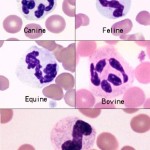The neutrophil, or the heterophil in birds, reptiles and some mammals, is the predominant granulocyte. In many species it is the predominant leukocyte in health. In health, usually only mature neutrophils are released from marrow to circulate in blood. Since mature neutrophils in prototypical human blood have nuclei that are segmented into lobes of condensed chromatin connected by filaments, mature neutrophils are called segmented neutrophils. The mature neutrophils of many animal species do not have a distinct lobe and filament arrangement (they do have constricted nuclei or irregular/knobbly nuclear outlines), nevertheless, they also are called segmented neutrophils. Neutrophils are part of the innate immune system and are the first line of (and are essential for) defense against bacterial pathogens. Neutrophils have a short half-life – they only persist for 10-15 hours once they have been released into peripheral blood.
Species differences

Normal mature neutrophils of several species are shown at the right.
- Canine neutrophils have white cytoplasm that contains small pink specific or secondary granules.
- Feline neutrophils have cytoplasm that is white and lacks visible granules.
- Equine neutrophils have white or slightly pink cytoplasm with no visible granules. The nuclei of equine neutrophils typically are long, thin and “knobby” with clumps of condensed chromatin projecting from the sides.
- Ruminant neutrophils have white cytoplasm with small pink granules; these impart an overall pink tint compared to the other species.
Rabbits, birds, amphibians and reptiles have heterophils. In contrast to the inconspicuous granules of neutrophils, granules in heterophils are large and stained deep orange to red.
